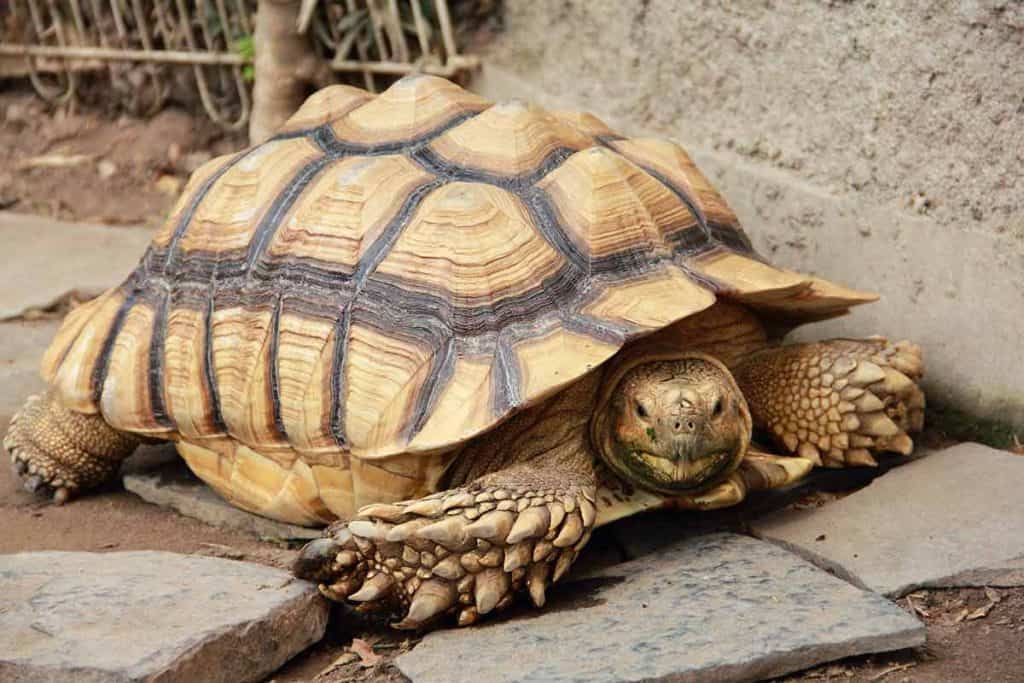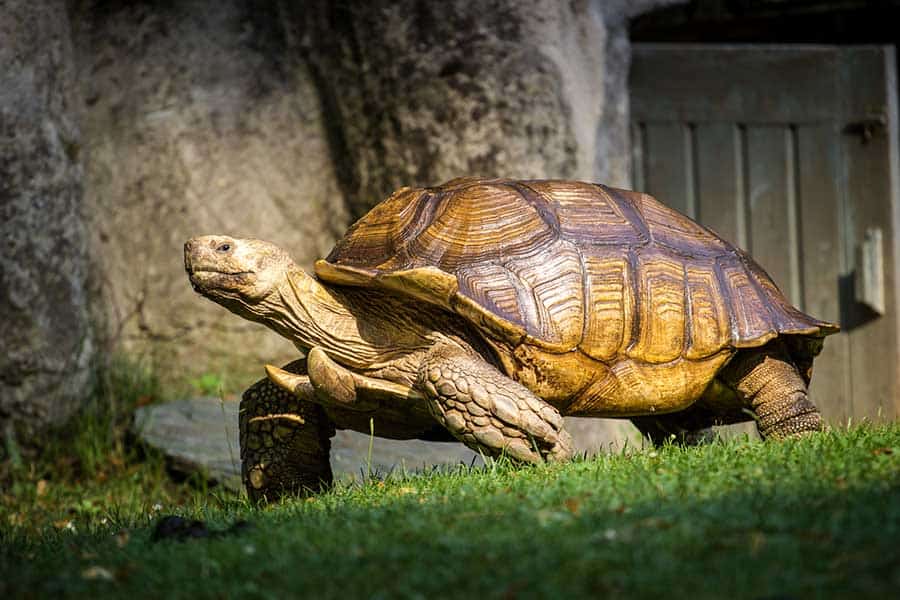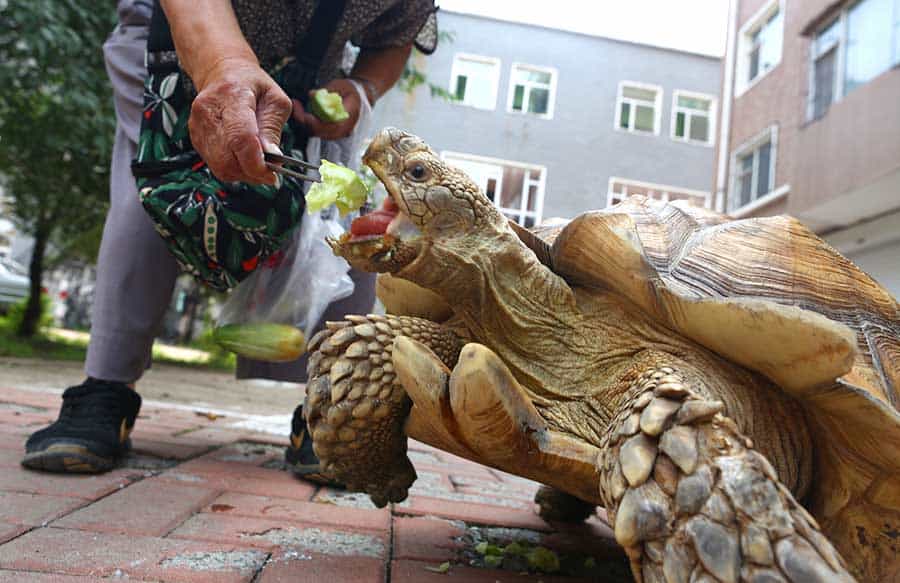
Sulcata tortoise care is actually pretty simple as long as you have the right climate and sulcata tortoise set up. This tortoise needs it warm and dry so if you’re in a cold, wet part of the world then this isn’t the pet for you!
This guide explains what the sulcata tortoise is, what their habitat should look like in your home, what you need to feed these tank-like torts, and what common health problems to look out for. Read on to learn more!
Where Do Sulcata Tortoises Come From?
These absolutely massive reptiles are also known as African spur-thighed tortoises. This is because they originate in Africa! “Sulcata” is actually the species name for this tortoise. Scientifically, they are known as Geochelone sulcata.
Sulcata tortoises come from all over Africa’s driest regions. They can be found in many different countries, such as Niger, Chad, Mali, Ethiopia, and essentially throughout Africa’s eastern coast to the Red Sea.
These parts of the African continent see very little rain. There are dry periods in these regions that can last for a few years! Fortunately, sulcata tortoises have evolved many traits that help them cope with these arid conditions, making their rather unforgiving habitat ideal for them.
Sulcata Tortoises Lifespan
Sulcata tortoises can live for more than 70 years. Knowing how to take care of one properly is essential to them reaching this magnificent age.
Size of Sulcata Tortoises
The sulcata tortoise is the largest species of tortoise native to Africa! They are also the largest species among those commonly recommended as pets (you do get larger tortoise species but they require specialist care from experts).
Sulcata hatchlings are relatively small and can measure at only one to two inches in length along their carapace (shell). Baby tortoises grow quite rapidly during their early years and will reach full size by 10 years old on average.
Adult sulcata tortoises will typically reach 25 to 30 inches in length along their carapace and will weigh an average of 100 pounds! However, the healthier and older your tortoise is, the larger and heavier they will be. Some very old sulcatas weigh in excess of 200 pounds and measure at 40+ inches!
Sulcata Tortoise Behaviour and Temperament
Sulcatas have evolved a specific behavior to deal with arid climates. They can dig vast burrows and tunnels with their huge, scaly feet! Their burrows can be 30 inches deep and may extend for 10 feet or more. Keep this in mind if you really love your garden!
Since sulcatas are so large and hardy, they are able to climb over rocks and stumps with ease. They are very curious, intelligent creatures and will explore their habitats to their hearts’ content. Unfortunately, this does lead to some mishaps, such as them tumbling over and landing on their backs.
If your sulcata manages to land itself on its back, gently pick it up and turn it over as soon as you can. If sulcatas are left on their backs for an extended period they can suffocate to death due to the weight of their shells putting pressure on their lungs.
These tortoises are gentle giants and are almost never aggressive to their owners or other pets, making them great companions for reptile lovers. They are very curious and need to roam freely outdoors to be healthy and happy.
What Does a Sulcata Look Like?
Sulcatas are a tan brown color that blends in with the desert sand of their homelands. They have light markings on their shells which break up their outline and make it harder for predators to spot them.
Their legs are covered in large, tough scales that grow outward. That’s why they are sometimes referred to as ‘spur-thighed’ or the African Spurred tortoise.
Sulcata Tortoise Enclosure Setup
Sulcatas start off small, but boy, do they grow quickly! As one of the largest tortoises on the planet, they can reach enormous sizes in a fairly short amount of time.

When they are hatchlings, it is possible to house them indoors. However, they will need access to a large area to roam in (ideally outdoors) as well as UVB lighting and a heat source (if housed indoors) to keep them warm, happy, and healthy.
Once sulcatas have reached a certain size, it is impractical to keep them indoors, and they should have an outdoor enclosure (sometimes known as tortoise tables set up for them).
Unfortunately, this is going to be tricky if you don’t live in a warm, dry climate.If you live in an area where temperatures get cold at night or in the winter, you’ll need lots of supplemental heat for your sulcata!
Whether they are indoors or outdoors, sulcatas need to have access to a temperature gradient, UVB lighting (either from a lamp or direct, natural sunlight), fresh water, and a private, shaded place to nap at all times.
Equipment For Sulcata Tortoise Keeping
- Large enclosure with shelters or sheds
- Ceramic heat emitter,
heat lamp or radiant heat panel - UVB lamp (if your tortoise is housed inside)
- Decorations like rocks and plants
- Shallow bath or container for bathing
- Hides
- Dry substrate
- Calcium supplements
- Water dish
- Feeding plate
Enclosure Size
As big as you think it should be, make it bigger! This is the mantra for sulcata tortoise enclosures.
For the first couple years of your tortoise’s life, they should be housed in a secure enclosure such as a glass tank. This is because they are small enough during this stage to be carried away by cats, birds, and other natural predators that can be found in your backyard.
Hatchlings and juveniles can be placed in indoor enclosures that are around 50+ gallons. This gives them room to grow and space to explore.
Once your tortoise is big enough that a bird or other predator won’t be able to pick them up and escape with them, you can safely move them outside.
Your sulcata will need an enclosure that is several feet in length and width. If you can give them your whole garden, then go ahead! However, be prepared for some changes.
Sulcatas can climb, so they need an enclosure with a fence that is at least two feet high all the way around it. This fence also needs to extend underground by at least 30 inches because sulcatas are expert diggers, too!
Your tortoise enclosure’s fence should be sturdy. Even young sulcatas are tough little tanks that can and will easily push over a plastic or wire garden fence.
Fences should not be see-through because this encourages the tortoise to try and escape. An opaque barrier will also keep other animals like potential predators as well as neighborhood dogs and cats from noticing your tortoise and stressing them out or potentially harming them.
Within their outdoor enclosure, your sulcata should have access to a hot basking spot and a cool spot so they are able to thermoregulate as needed. It is easy to set up a couple of shelters like dog houses or small sheds to accommodate these needs.
Humidity
Sulcatas need to be dry. Their enclosures should not exceed 50% humidity. High humidity leads to health issues like fungal infections and respiratory infections.
If you live in an area where the humidity is above 50%, then the sulcata tortoise is not the species for you. If you live in an area where the humidity is less than 50%, then you can mist the enclosure once daily or soak your sulcata regularly to keep humidity levels up.
Sulcatas also need hides to retreat to when they want some privacy. If you’re raising baby tortoises then it’s important that you include a humid hide as it can help prevent shell pyramiding in growing tortoises. One way of doing this is to put a wooden hide in the enclosure and soak it in water once a week.
Your sulcata’s enclosure must be kept dry. The odd bit of light rain is ok but it’s essential that your sulcata tortoise doesn’t get cold and wet.
If it rains and the temperature drops, bring your tort inside to keep it dry and warm, or have a warm, dry shelter set up for them, perhaps in your garage, a shed, or even just a designated “tortoise room” in your home.
Temperature and Heating
Owning a sulcata tortoise in an area that is particularly cool is not a good idea, as they need to be hot in order to be healthy.
You will need to provide a hot basking area for your tortoise so they can thermoregulate and adjust their body temperature as needed. This hot space should reach 90°F during the day and have a small basking spot with a temperature of 100°F.
At night, the temperature in their hot spot should not drop below 70°F. You can easily maintain this heat with a high-wattage
If your area’s average temperatures meet your tortoise’s needs, then you won’t necessarily need to set up a hot space. However, make sure that you keep an eye on temperature fluctuations and be ready to set up a hot space in case there is a sudden drop in temperature.
If you live in an area where the daytime temperature is too hot for your sulcata, then you will need to set up a cool spot. The cool spot should allow your tortoise to fully cool down in the shade, you could use a dog house, small shed, or shaded wallowing hole.
If your sulcata cannot cool down, they will dig a burrow to cool themselves down and escape the sun.
UVB Lighting
Your sulcata needs access to UVB light throughout the light portion of their daily photocycle. UVB light is essential for your tortoise to be able to absorb
If your sulcata is housed outdoors, then they will get this straight from direct sunlight. The natural rising and setting of the sun provides the perfect photocycle for them.
However, if your sulcata is housed indoors, then they will need a UVB lamp. This means you will need to create this photocycle by keeping their heat and UVB lights on for around 12 hours a day and off for the other 12 hours.
Substrate
Sulcatas can be housed on both grass and sand. Regardless of whether you use one or the other or a mixture of both, the key thing to remember is these tortoises need their substrate to remain dry, so avoid moisture-retaining substrates like sphagnum moss, for example.
If your tortoise is housed indoors, you can keep them on Timothy hay pellets, dry hay, or other dry, grassy, or sandy substrates.
If your sulcata has outdoor housing, they will naturally create a dirt path in any grass you have in your yard.
Decorations
Decorations are key in your sulcata’s surroundings for enrichment and privacy. Sulcatas are very curious and need mental stimulation in their enclosures. You can, for example, include some rocks of varying sizes and compacted little mounds of dirt to create hills, create a maze for them, or even include an area of plants that they can munch on.
Make sure that any little hills you create or rocks you place in the enclosure are not steep, slick, or sharp. If your sulcata tries to climb one of these sorts of surfaces, they may end up falling over and landing on their backs or injuring themselves.
Another thing to remember is that sulcatas love brightly colored food! However, they are not the best at determining what is food and what is not. Any children’s or dog’s toys that are left lying around their enclosures will get chomped on!
If your sulcata eats foreign objects they can become impacted, rupture their digestive tract, and become very ill if they eat things that are not meant to be eaten!
Water Sources and Baths
Sulcatas will need a shallow bath of cool, fresh water or ‘fresh’ mud to wallow in. This is to allow them to cool down in the middle of a very hot day. It will also help them regulate their temperature and metabolic processes. It also helps prevent them from becoming dehydrated.
You will find that this is where they do most of their pooping, too! This is because the water helps to stimulate their bowels. Therefore, just like with any other reptile, you will need to spot clean the enclosure daily.
Feeding Your Sulcata Tortoise
Sulcata tortoises are big boys and have appetites to match! You will need to feed them daily for five days of the week. Then give them a two-day break in order to regulate their digestive systems and fully process their food.

Two to three times a week, sprinkle some
Food
Sulcatas are herbivores. This means they do not eat any insect or animal-based protein and eat only plant matter.
75% to 80% of your tortoise’s diet should be made up of hay and grasses such as Timothy hay, alfalfa hay, lawn grasses, and other grassy hays.
To supplement their main diet of grass and hay, you can give your sulcata a variety of vegetables and greens such as:
- Cactus pads
- Endive
- Escarole
- Leaf lettuce
- Leafy greens
- Beet greens and beet tops
- Dandelion greens
- Turnip greens
- Mulberry leaves
- Grape leaves
- Hibiscus leaves
- Collard greens
- Mustard greens
- Yellow and orange squash
- Sweet potatoes
- Red and yellow bell peppers
Keep in mind these greens and vegetables should make up only about 10% to 20% of your tortoise’s diet.
Also, as an occasional treat, you can add some fruits to their diet, such as berries, mangoes, and watermelon with the rind on. However, fruit should only make up around 5% of your tortoise’s diet, as it is full of sugar that can cause obesity and gum rot.
It is a good idea to put at least one bright and colorful thing in every meal to promote enrichment.
Feed your tortoise a plate the size of their shell once a day, five days a week. It is important to feed them on some sort of ‘plate’ or surface and never straight on the ground. Sulcatas can eat sand and stones on accident, which will then cause impaction and health problems later on.
Learn more about what tortoises eat.
Water
Your sulcata should have access to fresh drinking water at all times. This should be in a shaded area so it doesn’t evaporate quickly. You should use a shallow dish which is low enough that your sulcata can easily reach in.
Make sure the shallow bowl is non-porous, sturdy, and heavy-bottomed so it doesn’t get tipped over easily by your tortoise.
Common Health Problems for Sulcata Tortoises
As with any exotic pets, there are a couple of tortoise-specific health issues you should know about. Sulcatas don’t often get shell rot, which is commonly associated with humid environments. However, they can get shell “pyramiding” and
Pyramiding
“Pyramiding” is an issue common in many tortoises. Too much protein in their diet will cause your sulcata’s shell to deform and look like little raised pyramids rather than one smooth surface. This is an indication that the tortoise’s kidneys are under strain and it needs urgent veterinary attention.
Pyramiding can also occur in growing tortoises if they don’t get enough humidity. If you notice any signs of pyramiding, see an exotic vet as soon as possible.
Calcium Deficiency
Like with most pet reptiles, a lack of
This is a weakening of the bones and joints which can cause your tortoise’s bones and shell to deform in very painful and debilitating ways. It must be treated immediately and aggressively. You can help prevent this by making sure your sulcata gets a healthy diet along with a source of
Respiratory Infections
Tortoises are also at risk of developing respiratory infections if the conditions in their enclosure aren’t right. Respiratory illnesses often start as a runny nose but as they get worse your tortoise might lose its appetite, and stop moving around. If you see any of these signs, see a vet immediately.
Tortoises often get respiratory issues when their immune systems are run down from being exposed to cold temperatures and wet conditions. They can also get nasty respiratory illnesses from harmful fungal spores and bacteria if their enclosures are not kept clean, dry and with the proper humidity.
Make sure you give your sulcata tortoise the proper care it needs to stay happy and healthy.
FAQs About Sulcata Tortoise Care
Sulcatas are herbivores, which means they will not eat other pets. However, they should never be left alone with other animals unless they are well socialized, as even though sulcatas are fairly mild-mannered, they can occasionally bite if they feel threatened.
Sulcatas are relatively easy to care for if you live in the right climate. For example, Texas is an excellent climate for a sulcata tortoise because it is warm and dry, just like the natural climate in parts of Africa.
Sulcatas can be housed in small groups, provided there is enough space for all of them. Only keep sulcatas of similar sizes in the same enclosure to avoid bullying and aggression.
Sulcata tortoises do not hibernate, although they do like to spend time in burrows when they get too warm or cold.
Slowly Strolling Off…
Though sulcatas are very large animals, caring for them is remarkably easy to master once you have the basics down.
These tanky-torts can come to recognize their owners and will greet you enthusiastically, especially if you are bringing them food! Their curious, docile temperaments make them excellent pets and delightful companions.
Just remember that sulcata tortoises are incredibly long-lived so when you take on a baby sulcata you are potentially taking on a lifelong commitment.
Good luck on your adventure with your new scaly best friend for life!





